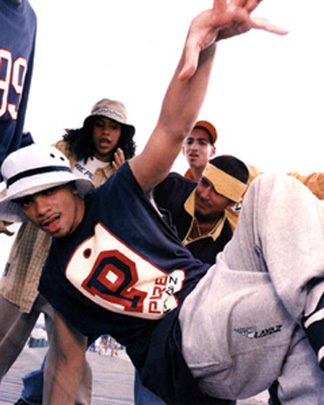A new way to hip-hop
Full Circle Productions
The Kennedy Center Family Theater
Washington DC
April 28-30, 2006
by Kate Mattingly
copyright ©2006, Kate Mattingly
 Performances by New York-based hip-hop group Full Circle at The Kennedy Center over the weekend were a healthy antidote to the messages that dominate urban music and dance today. So much of current hip hop scene has become mired in the glorification of “pimps” and “gangstas;” it’s always a little disconcerting to hear a 12–year old singing along with a song about “favorite positions.” In Full Circle’s show “Hip-Hop to da Head,” the more wholesome aspects of the art-form are emphasized. In one scene the women sing a capella, “Peace will come once we have togetherness,” which could have served as a tag-line for the performance.
Performances by New York-based hip-hop group Full Circle at The Kennedy Center over the weekend were a healthy antidote to the messages that dominate urban music and dance today. So much of current hip hop scene has become mired in the glorification of “pimps” and “gangstas;” it’s always a little disconcerting to hear a 12–year old singing along with a song about “favorite positions.” In Full Circle’s show “Hip-Hop to da Head,” the more wholesome aspects of the art-form are emphasized. In one scene the women sing a capella, “Peace will come once we have togetherness,” which could have served as a tag-line for the performance.
Even the name of the group is a fitting image for their message. In the 1970s and 1980s breakdancers often formed a circle, called a “cipher,” in which dancers took turns moving into the center and showing off their individual feats. Full Circle used a cipher to open “Hip-Hop to da Head,” and to feature the trademark style of each performer. Anita “Rokafella” Garcia and Gabriel “Kwikstep” Dionisio, the directors of the group — as well as husband and wife — are multi-talented performers. They have culled an eclectic group to join them, a cast of 13 which includes singers, rappers, beat-boxers and dancers.
Their show catered to the younger members of the audience who filled the Family Theater at The Kennedy Center, and it was refreshing to see a demographic and age-range that is often missing from traditional performing arts venues. Highlights of the show included Kwikstep’s incredible spins on his head — perfect revolutions in gravity-defying shapes — as well as his explanation of how such steps are learned from “masters” and “legends” who take years if not lifetimes to perfect breakdancing moves that happen in the blink of an eye.
“The reality is we all suffer from duality” was another stimulating idea offered in a monologue by Jaki Brown called “Shoe Peace.” She described the pull between two cultures represented in the different outfits she wears: classy heels cater to her Latin roots while sneakers and a baseball cap come from her love of hip hop fashion. Eventually she decides to “be like a DJ and spin it in the mix,” which is a clever way to use the music form associated with hip hop to explain the fusion of different styles that has become our 21st century world.
Another connection with current times was made in a scene called “The Front Line,” which described an army recruiter luring a talented but money-poor dancer to enlist. The ensemble reenacted scenes of training and battle, and it was interesting — and frightening — to see how the isolations of the body used in popping could simulate a body being hit by bullets. Baba rapped “When I hear the drum track, I wonder if he’s coming back.” Even the aggression in breakdancing was perfect for this scene describing the military, and connects to the roots of breakdancing in battles that were played out between rival crews.
Along with the choreographed scenes — which were performed with exceptional flow — rapping and freestyling added vocal elements. It was interesting to hear how the syncopation in the voices — words following one another in unusual rhythms — mirrored the syncopation in the choreography, when dancers seemed to suspend the beat and then riddle their bodies with rapid-fire steps.
Very often hip hop groups, such as Rennie Harris’ Puremovement, are dominated by men, and one of the most refreshing aspects of Full Circle is that the company embraces both genders. They also excel at presenting a show that doesn’t dumb-down the material for a family audience. They present real issues — such as the war in Iraq and its impact on lower economic communities — and their dancing is top-notch. One classroom scene about a teacher and students who seemed to prefer dancing to learning was a little confusing. Could this have been their message? I would have thought the Full Circle would understand the importance of education — both in the mind and the body. Perhaps this scene needs to be re-examined. But overall the show is wholesome and entertaining.
It was great that The Kennedy Center presented “Hip-Hop to da Head” and I look forward to more such audience-broadening events. Washington DC has its own hip hop group, Culture Shock, which is dedicated to promoting healthy lifestyles, physical fitness, and community involvement through the power of Hip Hop music and dance. It would fantastic to see Full Circle and Culture Shock collaborate on a project. [In the meantime, Culture Shock will participate in huge hip-hop event in DC this weekend called the East Coast Dance Competition. For more info, http://www.eastcoastdancecomp.com/.]
Both groups move the younger generations away from the messages of chauvinism and sexism that dominate too much of urban music today.
Volume 4, No. 17
May 1, 2006
copyright ©2006 Kate Mattingly
www.danceviewtimes.com